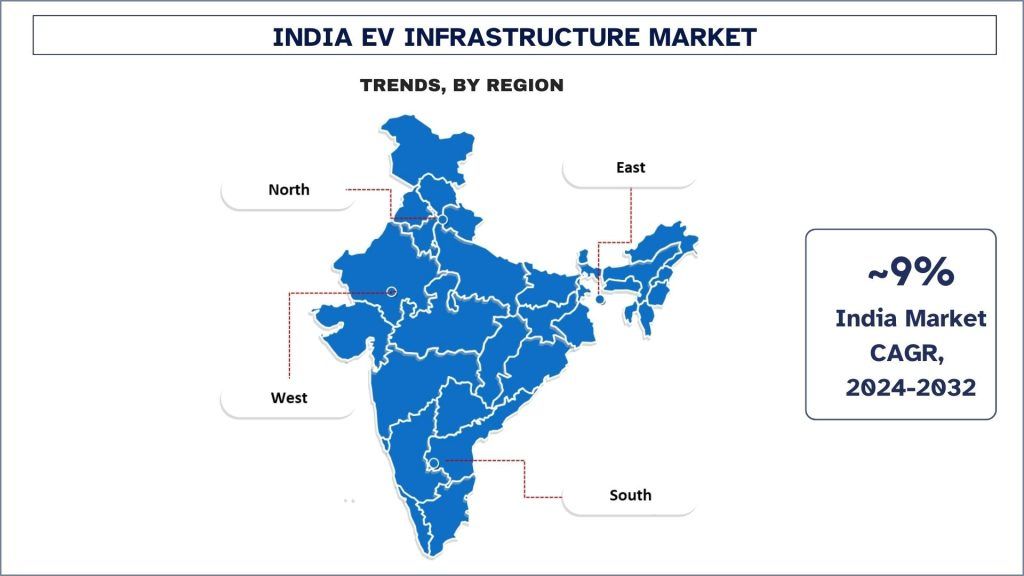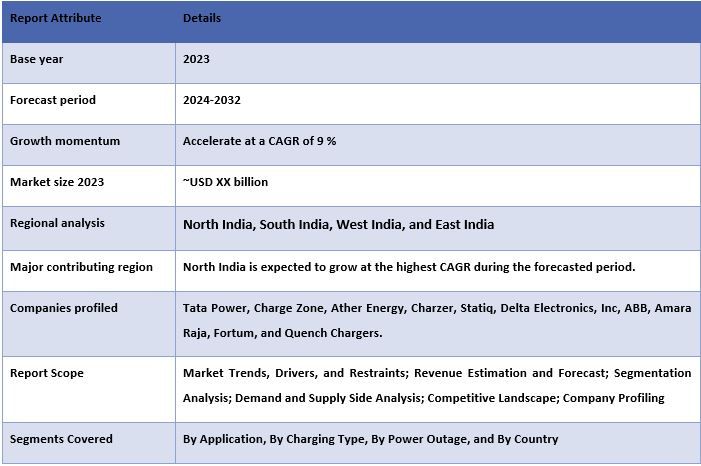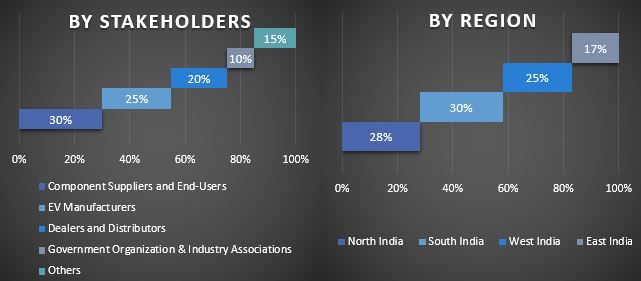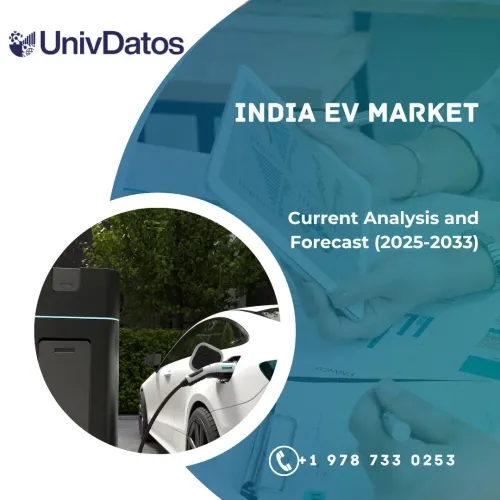- Home
- About Us
- Industry
- Services
- Reading
- Contact Us
India EV Infrastructure Market: Current Analysis and Forecast (2024-2032)
Emphasis on Application (Public and Private); Charging Type (Fast and Slow); Power Output (Less than 22KW and More than 22KW)); and Region/Country
India EV Infrastructure Market Size & Forecast
The India EV Infrastructure market was valued at approximately USD XX Billion in 2023 and is expected to grow at a robust CAGR of around 9% during the forecast period (2024-2032) owing to the rising urbanization, affordability, increasing disposable income, and the shift towards electric mobility.
India EV Infrastructure Market Analysis
A major factor supporting EV vehicles is the EV infrastructure. This includes public and private sector battery charging stations, charging types, rapid charging stations, connections, and fast charging stations. Therefore, the increasing proportion of toxic and noxious gases from transport necessitates the adoption of electric vehicles. In addition, the government has also implemented rules and regulations to keep the area green and eco-friendly. The spread of charging infrastructure is essential for the spread of EVs. In addition, market key players are working to enhance the network of the EV infrastructure. For instance, in 2022, Hyundai Motor India Limited (HMIL) and Tata Power announced a partnership to expand the scope of electric vehicles (EV) charging infrastructure across the country and will set up DC 60 kW fast chargers across 34 of its EV dealer locations across 29 cities in India.
India EV Infrastructure Market Trends
This section discusses the key market trends influencing the India EV Infrastructure segments as identified by our research experts.
Public Segment Transforming Industry
Based on application, the market is segmented into public and private. The public category is to witness a higher CAGR during the forecast period. This is due to the widespread use of public quick chargers to promote EV adoption. In addition, various OEMs and EV grid operators are installing public fast chargers in locations such as retail stores, hospitality facilities, parking lots, government offices, roadways, and gas stations. However, most EV infrastructure is open to the public for the benefit of the customer.

North India Dominated the Market in 2023
The growth of the EV infrastructure market in North India is primarily driven by government initiatives such as the FAME II scheme and various state-level policies that incentivize the development of charging stations. Urbanization and smart city projects in key regions like Delhi, Gurgaon, and Noida are integrating EV infrastructure as part of sustainable urban planning. Rising environmental awareness among consumers is boosting the adoption of electric vehicles, particularly in the two-wheeler and three-wheeler segments, which is driving the demand for accessible charging solutions. This combination of policy support, urban development, and increasing EV adoption is creating strong growth opportunities for EV infrastructure in the region.

India EV Infrastructure Industry Overview
India EV Infrastructure is competitive, with several Indian and international market players. The key players are adopting different growth strategies to enhance their market presence, such as partnerships, agreements, collaborations, new product launches, geographical expansions, and mergers and acquisitions. Some of the major players operating in the market are Tata Power, Charge Zone, Ather Energy, Charzer, Statiq, Delta Electronics, Inc, ABB, Amara Raja, Fortum, and Quench Chargers.
India EV Infrastructure Market News
- For instance, in 2024, Kazam, a technology company focusing on e-mobility solutions, secured $8 million in a Series A3 funding round. The investment was led by Vertex Ventures Southeast Asia and India, with participation from Avaana Capital, Alteria Capital, and other investors.
- Kazam raises Series A3 funding to expand its innovative charging solutions across India’s growing electric vehicle market, aims to address range anxiety, and supports the nation’s EV adoption through its integrated software and hardware platforms.
India EV Infrastructure Market Report Coverage

Reasons to buy this report:
- The study includes market sizing and forecasting analysis validated by authenticated key industry experts.
- The report presents a quick review of overall industry performance at one glance.
- The report covers an in-depth analysis of prominent industry peers with a primary focus on key business financials, product portfolios, expansion strategies, and recent developments.
- Detailed examination of drivers, restraints, key trends, and opportunities prevailing in the industry.
- The study comprehensively covers the market across different segments.
- Deep dive regional level analysis of the industry.
Customization Options:
India EV Infrastructure can further be customized as per the requirement or any other market segment. Besides this, UMI understands that you may have your own business needs; hence, feel free to connect with us to get a report that completely suits your requirements.
Table of Content
Research Methodology for the India EV Infrastructure Market Analysis (2022-2032)
Analyzing the historical market, estimating the current market, and forecasting the future market of the India EV Infrastructure market were the three major steps undertaken to create and analyze the adoption of India EV Infrastructure in major regions. Exhaustive secondary research was conducted to collect the historical market numbers and estimate the current market size. Secondly, numerous findings and assumptions were taken into consideration to validate these insights. Moreover, exhaustive primary interviews were also conducted, with industry experts across the value chain of the India EV Infrastructure market. Post assumption and validation of market numbers through primary interviews, we employed a top-down/bottom-up approach to forecasting the complete market size. Thereafter, market breakdown and data triangulation methods were adopted to estimate and analyze the market size of segments and sub-segments of the industry. Detailed methodology is explained below:
Analysis of Historical Market Size
Step 1: In-Depth Study of Secondary Sources:
A detailed secondary study was conducted to obtain the historical market size of the India EV Infrastructure market through company internal sources such as annual reports & financial statements, performance presentations, press releases, etc., and external sources including journals, news & articles, government publications, competitor publications, sector reports, third-party database, and other credible publications.
Step 2: Market Segmentation:
After obtaining the historical market size of India EV Infrastructure, we conducted a detailed secondary analysis to gather historical market insights and share for different segments & sub-segments for major regions. Major segments are included in the report, such as application, charging type, and power outage, and region. Further country-level analyses were conducted to evaluate the overall adoption of testing models in that region.
Step 3: Factor Analysis:
After acquiring the historical market size of different segments and sub-segments, we conducted a detailed factor analysis to estimate the current market size of the India EV Infrastructure market. Further, we conducted factor analysis using dependent and independent variables such as application, charging type, and power outage, and India EV Infrastructure regions. A thorough analysis was conducted of demand and supply-side scenarios considering top partnerships, mergers and acquisitions, business expansion, and product launches in the India EV Infrastructure market sector across the globe.
Current Market Size Estimate & Forecast
Current Market Sizing: Based on actionable insights from the above three steps, we arrived at the current market size, key players in the India EV Infrastructure market, and market shares of the segments. All the required percentage shares split, and market breakdowns were determined using the above-mentioned secondary approach and were verified through primary interviews.
Estimation & Forecasting: For market estimation and forecast, weights were assigned to different factors including drivers & trends, restraints, and opportunities available for the stakeholders. After analyzing these factors, relevant forecasting techniques i.e., the top-down/bottom-up approach were applied to arrive at the market forecast for 2032 for different segments and sub-segments across the major markets. The research methodology adopted to estimate the market size encompasses:
- The industry’s market size, in terms of revenue (USD) and the adoption rate of the India EV Infrastructure across the major markets domestically
- All percentage shares, splits, and breakdowns of market segments and sub-segments
- Key players in the India EV Infrastructure in terms of products offered. Also, the growth strategies adopted by these players to compete in the fast-growing market
Market Size and Share Validation
Primary Research: In-depth interviews were conducted with the Key Opinion Leaders (KOLs), including Top Level Executives (CXO/VPs, Sales Head, Marketing Head, Operational Head, Regional Head, Country Head, etc.) across major regions. Primary research findings were then summarized, and statistical analysis was performed to prove the stated hypothesis. Inputs from primary research were consolidated with secondary findings, hence turning information into actionable insights.
Split of Primary Participants in Different Regions

Market Engineering
The data triangulation technique was employed to complete the overall market estimation and to arrive at precise statistical numbers for each segment and sub-segment of the India EV Infrastructure. Data was split into several segments and sub-segments after studying various parameters and trends in the application, charging type, and power outage, and regions of the India EV Infrastructure market.
The main objective of the India EV Infrastructure Market Study
The current & future market trends of the India EV Infrastructure were pinpointed in the study. Investors can gain strategic insights to base their discretion for investments on the qualitative and quantitative analysis performed in the study. Current and future market trends determined the overall attractiveness of the market at a regional level, providing a platform for the industrial participant to exploit the untapped market to benefit from a first-mover advantage. Other quantitative goals of the studies include:
- Analyze the current and forecast market size of the India EV Infrastructure market in terms of value (USD). Also, analyze the current and forecast market size of different segments and sub-segments.
- Segments in the study include areas of application, charging type, and power outage, and regions.
- Define and analyze the regulatory framework for the India EV Infrastructure
- Analyze the value chain involved with the presence of various intermediaries, along with analyzing customer and competitor behaviors of the industry.
- Analyze the current and forecast market size of the India EV Infrastructure market for the major regions.
- Major regions studied in the report include North India, West India, South India and East India
- Company profiles of the India EV Infrastructure market and the growth strategies adopted by the market players to sustain in the fast-growing market.
- Deep dive regional level analysis of the industry.
Frequently Asked Questions FAQs
Q1: What is India EV Infrastructure current size and growth potential?
Q2: What are the driving factors for the growth of India EV Infrastructure Market?
Q3: Which segment has the largest share of the India EV Infrastructure by application?
Q4: What are the emerging technologies and trends in India EV Infrastructure Market?
Q5: Which region will dominate the India EV Infrastructure Market?
Related Reports
Customers who bought this item also bought











